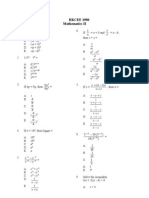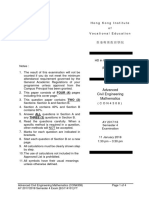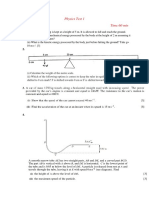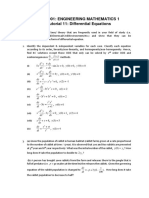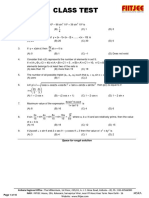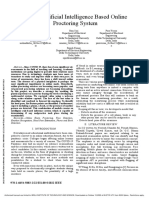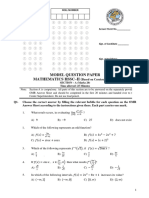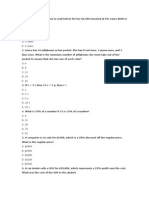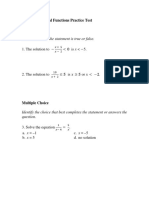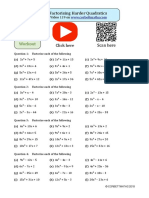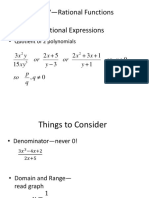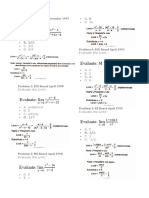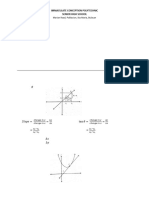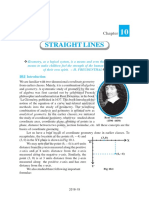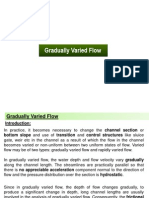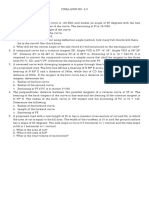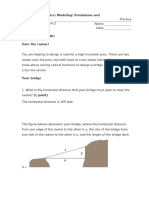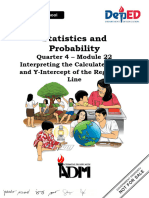12 Mathematics Ncert Ch09 Differential Equations 9.4 Sol
12 Mathematics Ncert Ch09 Differential Equations 9.4 Sol
Uploaded by
Bhaskarjyoti PhukanCopyright:
Available Formats
12 Mathematics Ncert Ch09 Differential Equations 9.4 Sol
12 Mathematics Ncert Ch09 Differential Equations 9.4 Sol
Uploaded by
Bhaskarjyoti PhukanOriginal Description:
Copyright
Available Formats
Share this document
Did you find this document useful?
Is this content inappropriate?
Copyright:
Available Formats
12 Mathematics Ncert Ch09 Differential Equations 9.4 Sol
12 Mathematics Ncert Ch09 Differential Equations 9.4 Sol
Uploaded by
Bhaskarjyoti PhukanCopyright:
Available Formats
CLASS –XII MATHEMATICS NCERT SOLUTIONS
Differential Equations
Exercise 9.4
Answers
dy 1 − cos x 1 − cos x
1. Given: Differential equation = ⇒ dy = dx
dx 1 + cos x 1 + cos x
x
2sin 2
x
Integrating both sides, ∫ dy = ∫ 2 2x dx ⇒ y = ∫ tan 2
2
dx
2 cos
2
x
tan
x 2 −x+c
⇒ ∫ sec − 1 dx ⇒
2
2 1
2
x
⇒ y = 2 tan −x+c Ans.
2
dy
2. Given: Differential equation = 4 − y2 ⇒ dy = 4 − y 2 dx
dx
dy
⇒ = dx
4 − y2
dy
Integrating both sides, ∫ 4 − y2
dy = ∫ 1 dx
y 1 x
⇒ sin −1 = x+c ∵ ∫ 2 dx = sin −1
2 a − x2 a
y
⇒ = sin ( x + c ) ⇒ y = 2sin ( x + c ) Ans.
2
dy dy
3. Given: Differential equation + y =1 ⇒ = 1− y
dx dx
dy
⇒ dy = (1 − y ) dx ⇒ dy = − ( y − 1) dx ⇒ = − dx
y −1
dy
Integrating both sides, ∫ y − 1 dy = − ∫ 1 dx
⇒ log y − 1 = − x + c ⇒ y − 1 = e− x + c ∵ if log x = t , then x = e x
⇒ y − 1 = ±e − x + c ⇒ y = 1 ± e − x ec ⇒ y = 1 ± ec e − x
⇒ y = 1 + Ae− x , where A = ±ec Ans.
4. Given: Differential equation sec 2 x tan y dx + sec2 y tan x dy = 0
sec2 x sec 2 y
Dividing by tan x tan y, we have dx + dy = 0
tan x tan y
Material downloaded from http://myCBSEguide.com and http://onlineteachers.co.in
Portal for CBSE Notes, Test Papers, Sample Papers, Tips and Tricks
f '( x)
⇒ log tan x + log tan y = log c ∵ ∫ dx = log f ( x )
f ( x)
⇒ log tan x tan y = log c ⇒ tan x tan y = c
⇒ tan x tan y = ± c = C ∵ t = a ( a ≥ 0 ) ⇒ t = ± a Ans.
5. Given: Differential equation (e x
+ e − x ) dy − ( e x − e− x ) dx = 0
e x − e− x
⇒ ( e x + e− x ) dy = ( e x − e− x ) dx ⇒ dy = x − x dx
e +e
e x − e− x
Integrating both sides, ∫ ∫ e x + e− x
dy = dx
f '( x)
⇒ y = log e x + e − x + c ∵ ∫ dx = log f ( x ) Ans.
f ( x)
= (1 + x 2 )(1 + y 2 )
dy
6. Given: Differential equation
dx
dy = (1 + x 2 )(1 + y 2 ) dx = (1 + x 2 ) dx [Separating variables]
dy
⇒ ⇒
1+ y 2
dy = ∫ ( x 2 + 1) dx
1
Integrating both sides, ∫y 2
+1
−1 x3
⇒ tan y = + x + c Ans.
3
7. Given: Differential equation y log y dx − x dy = 0 ⇒ − x dy = − y log y dx
dy dx
⇒ = [Separating variables]
y log y x
dy dx
Integrating both sides, ∫ y log y = ∫ x
1 dt dy
Putting log y = t on L.H.S., we get = ⇒ = dt
y dy y
dt dx
Now eq. (i) becomes
t ∫
=∫
x
⇒ log t = log x + log c = log xc
[If all the terms in the solution of a differential equation involve log, it is better to use log c or
log c instead of c in the solution.]
⇒ t = xc ⇒ t = ± xc ⇒ log y = ± xc = ax where a = ± c
⇒ y = eax
dy
8. Given: Differential equation x5 = − y5 ⇒ x5 dy = − y 5 dx
dx
Material downloaded from http://myCBSEguide.com and http://onlineteachers.co.in
Portal for CBSE Notes, Test Papers, Sample Papers, Tips and Tricks
dy dx
⇒ 5
=− 5 [Separating variables] ⇒ y −5 dy = − x −5 dx
y x
y −4 x −4
Integrating both sides −5 −5
∫ y dy = − ∫ x dx ⇒ = +c
−4 −4
⇒ y −4 = − x −4 − 4c ⇒ y −4 = x −4 + y −4 = −4c
⇒ y −4 = x −4 + y −4 = C , where C = − 4c Ans.
dy
9. Given: Differential equation = sin −1 x ⇒ dy = sin −1 x dx
dx
−1
Integrating both sides, ∫ 1 dy = ∫ sin x dx ⇒ y = ∫ sin −1 x.1 dx
Applying product rule, I II
y = ( sin −1 x ) ∫ 1 dx − ∫ ( sin −1 x ) ∫ 1 dx dx = x sin −1 x − ∫
d 1
x dx ……….(i)
dx 1 − x2
x 1 −2 x
To evaluate ∫ 1 − x2
dx = − ∫
2 1 − x2
dx
Putting, 1 − x 2 = t , differentiate −2 x dx = dt
x 1 dt 1 −1 2 1 t1 2
∫ − = − t = − 1 − x2
2∫ t 2∫
⇒ dx = − = − t dt = .
1 − x2 2 12
Putting this value in eq. (i), the required general solution is
y = x sin −1 x + 1 − x 2 + c Ans.
10. Given: Differential equation e tan y dx + (1 − e ) sec y dy = 0
x x 2
Dividing each term by (1 − e x ) tan y, we get
ex sec 2 y
dx + dy = 0 [Separating variables]
1 − ex tan y
ex sec 2 y
Integrating both sides, ∫ 1− ex dx + ∫ tan y dy = c
−e x
⇒ −∫ dx + log tan y = c ⇒ − log 1 − e x + log tan y = c
1 − ex
tan y tan y
⇒ log = log c ' ⇒ = c'
1 − ex 1 − ex
⇒ tan y = C (1 − e x ) ∵ t = c ' ⇒ t = ± c ' = C (say) Ans.
11. Given: (x 3
+ x 2 + x + 1)
dy
dx
= 2x2 + x ⇒ (x 3
+ x 2 + x + 1) dy = ( 2 x 2 + x ) dx
2x2 + x
⇒ dy = dx [Separating variables]
x3 + x2 + x + 1
Material downloaded from http://myCBSEguide.com and http://onlineteachers.co.in
Portal for CBSE Notes, Test Papers, Sample Papers, Tips and Tricks
2 x2 + x 2x2 + x
⇒ dy = dx ⇒ dy = dx
x 2 ( x + 1) + ( x + 1) ( x + 1) ( x 2 + 1)
2 x2 + x 2x2 + x
Integrating both sides, ∫ 1 dy = ∫ ( x + 1) ( x 2 + 1)
dx ⇒ y=∫
( x + 1) ( x 2 + 1)
dx …(i)
A Bx + C
Let + 2 [Partial fraction] ……….(ii)
x +1 x +1
⇒ 2 x 2 + x = A ( x 2 + 1) + ( Bx + C )( x + 1)
Comparing the coefficients of x 2 on both sides, A+B=2 ……….(iii)
Comparing the coefficients of x on both sides, B+C=1 ……….(iv)
Comparing constants on both sides, A+C=0 ……….(v)
From eq. (iii) – (iv), we have A–C=1 ……….(vi)
1
Adding eq. (v) and (vi), we have 2A = 1 ⇒ A=
2
−1
From eq. (v), we have C=–A=
2
1 1 3
Putting the value of C in eq. (iv), B–=1 ⇒ B=1+ =
2 2 2
Putting the values of A, B, and C in eq. (ii), we have
1 3 1
x−
2x2 + x 1 1 3 x 1 1
= 2 +22 2 = . + . 2 − . 2
( x + 1) ( x + 1) x + 1 x + 1
2
2 x +1 2 x +1 2 x +1
1 1 3 2x 1 1
= . + . 2 − . 2
2 x +1 4 x +1 2 x +1
Putting this value in eq. (i),
1 1 3 2x 1 1
y= ∫ dx + ∫ 2 dx − ∫ 2 dx
2 ( x + 1) 4 x +1 2 x +1
log ( x + 1) + log ( x 2 + 1) − tan −1 x + c
1 3 1
⇒ y= ……….(vii)
2 4 2
2x f '( x)
∵ ∫ 2 dx = ∫ dx = log f ( x )
x +1 f ( x)
Now, when x = 0, y = 1 , putting these values in eq. (vii),
1 3 1
1= log1 + log1 − tan −1 0 + c ⇒ 1= c log1 = 0, tan −1 0 = 0
2 4 2
Putting value of c in eq. (vii), the required general solution is
y = log ( x + 1) + log ( x 2 + 1) − tan −1 x + 1
1 3 1
2 4 2
y = 2 log ( x + 1) + 3log ( x 2 + 1) − tan −1 x + 1
1 1
⇒
4 2
Material downloaded from http://myCBSEguide.com and http://onlineteachers.co.in
Portal for CBSE Notes, Test Papers, Sample Papers, Tips and Tricks
1
( ) ( ) − 1 tan −1 x + 1
3
y= + + +
2
⇒ log x 1 log x 2
1
4
2
y = log ( x + 1) ( x 2 + 1) − tan −1 x + 1
1 2 3 1
⇒ Ans.
4 2
x ( x 2 − 1)
dy dx
12. Given: Differential equation =1 ⇒ dy =
dx x ( x 2 − 1)
1
Integrating both sides, ∫ 1 dy = ∫ x ( x 2
− 1)
dx
1
⇒ y=∫ dx + c ……….(i)
x ( x + 1)( x − 1)
1 A B C
Let = + + ……….(ii)
x ( x + 1)( x − 1) x x + 1 x − 1
⇒ 1 = A ( x + 1)( x − 1) + Bx ( x − 1) + Cx ( x + 1)
⇒ 1 = A ( x 2 − 1) + B ( x 2 − x ) + C ( x 2 + x ) ⇒ 1 = Ax 2 − A + Bx 2 − Bx + C x 2 + Cx
Comparing the coefficients of x 2 on both sides, A+B+C=0 ……….(iii)
Comparing the coefficients of x on both sides, −B + C = 0 ⇒ C=B ……….(iv)
Comparing constants on both sides, −A = 1 ⇒ A = −1 ……….(v)
Putting A = − 1 and C = B in eq. (iii),
1
−1 + B + B = 0 ⇒ 2B = 1 ⇒ B=
2
1
From eq. (iv), C=B=
2
Putting the values of A, B and C in eq. (ii), we get
1 1
1 −1
= + 2 + 2
x ( x + 1)( x − 1) x x + 1 x − 1
1 1 1 1 1 1
⇒ ∫ x ( x + 1)( x − 1) dx = − ∫ x dx + ∫
2 x +1
dx + ∫
2 x −1
dx
1 1 1
⇒ ∫ x ( x + 1)( x − 1) dx = − log x + 2 log x + 1 + 2 log x − 1
1 1
⇒ ∫ x ( x + 1)( x − 1) dx = 2 2 − log x + log x + 1 + log x − 1
1 1
∫ x ( x + 1)( x − 1) dx = 2 − log x + log x + 1 x − 1
2
⇒
1 1 x2 − 1 1 x2 −1
⇒ ∫ x ( x + 1)( x − 1) dx =
2
log
x
2
=
2
log
x2
Material downloaded from http://myCBSEguide.com and http://onlineteachers.co.in
Portal for CBSE Notes, Test Papers, Sample Papers, Tips and Tricks
Putting this value in eq. (i),
1 x2 − 1
y = log +c ……….(v)
2 x2
Now, putting y = 0, when x = 2 in eq. (v), we get
1 3 −1 3
0= log + c ⇒ c = log
2 4 2 4
Putting the value of c in eq. (v), the required general solution is
1 x2 −1 1 3
y = log 2
− log
2 x 2 4
1 x 1 2x
[NOTE: You can also do, to evaluate ∫ x(x 2
− 1)
dx = ∫ x (x
2 2
− 1)
dx = ∫
2 x ( x 2 − 1)
2
dx
Put x 2 = t ]
dy
13. Given: Differential equation cos = a ( a ∈ R ) ; y = 1 when x = 0
dx
dy = ( cos −1 x ) dx
dy
⇒ = cos −1 a ⇒
dx
∫ 1 dy = ∫ ( cos a ) dx y = ( cos −1 a ) ∫ 1 dx
−1
Integrating both sides, ⇒
⇒ y = ( cos −1 a ) x + c ……….(i)
Now putting y = 1 when x = 0 in eq. (i), we get c =1
y −1
Putting c = 1 in eq. (i), y = ( cos −1 a ) x + 1 ⇒ = cos −1 a
x
y −1
⇒ cos =a Ans.
x
dy
14. Given: Differential equation = y tan x ⇒ dy = y tan x dx
dx
dy
⇒ = tan x dx [Separating variables]
y
1
Integrating both sides, ∫y dy = ∫ tan x dx ⇒ log y = log sec x + log c
⇒ log y = log c sec x ⇒ y = c sec x ⇒ y = ± c sec x
⇒ y = C sec x where ±c = C ……….(i)
Now putting y = 1 and x = 0 in eq. (i), we get 1 = Csec 0 = C
Putting C = 1 in eq. (i), we get the required general solution ⇒ y = sec x
dy
15. Given: Differential equation y ' = e x sin x ⇒ = e x sin x
dx
⇒ dy = e x sin x dx
Material downloaded from http://myCBSEguide.com and http://onlineteachers.co.in
Portal for CBSE Notes, Test Papers, Sample Papers, Tips and Tricks
∫ 1 dy = ∫ e ⇒ y=I+C
x
Integrating both sides sin x dx ………(i)
where I = ∫ e x sin x dx ……….(ii)
Applying product rule,
I = e x ( − cos x ) − ∫ e x ( − cos x ) dx ⇒ I = −e x cos x + ∫ e x cos x dx
Again applying product rule,
I = − e x cos x + e x sin x − ∫ e x sin x dx ⇒ I = e x ( − cos x + sin x ) − I [By eq. (ii)]
ex
⇒ 2I = e x ( sin x − cos x ) ⇒ I= ( sin x − cos x )
2
Putting this value of I in eq. (i), we get
1
y = e x ( sin x − cos x ) + c ……….(iii)
2
Now putting x = 0 and y = 0 in eq. (iii)
1 1
0= ( −1) + c ⇒ c=
2 2
Putting the value of c in eq. (iii), we get the required general solution
1 1
y = e x ( sin x − cos x ) + ⇒ 2 y = e x ( sin x − cos x ) + 1
2 2
⇒ 2 y − 1 = e x ( sin x − cos x ) Ans.
dy
16. Given: Differential equation xy = ( x + 2 )( y + 2 ) ⇒ xy dy = ( x + 2 )( y + 2 ) dx
dx
y x+2
⇒ dy = dx [Separating both sides]
y+2 x
y x+2
Integrating both sides ∫ y+2 dy = ∫
x
dx
y+2−2 x x y+2 2 x
⇒ ∫ y+2
dy = ∫ + dx
x 2
⇒ ∫ y+2− y+2 dy = ∫ 1+
2
dx
2 x
⇒ ∫1 − y + 2 dy = ∫ 1+
2
dx ⇒ y − 2 log y + 2 = x + 2 log x + c
y − x = log ( y + 2 ) + log ( x ) + c y − x = log ( y + 2 ) . ( x ) + c ……….(i)
2 2 2 2
⇒ ⇒
Now putting x = 1, y = −1 in eq. (i),
−1 − 1 = log (1) + c ⇒ c = −2
Putting this value of c in eq. (i) to get the required solution curve
y − x = log ( y + 2 ) . ( x ) − 2 y − x + 2 = log ( y + 2 ) . ( x )
2 2 2 2
⇒ Ans.
17. Let P ( x, y ) be any point on the required curve.
According to the question, Slope of the tangent to the curve at P ( x, y ) × y = x
Material downloaded from http://myCBSEguide.com and http://onlineteachers.co.in
Portal for CBSE Notes, Test Papers, Sample Papers, Tips and Tricks
dy
⇒ .y = x ⇒ y dy = x dx
dx
y 2 x2
Integrating both sides, ∫ y dy = ∫ x dx ⇒ = +c
2 2
⇒ y 2 = x 2 + 2c ⇒ y 2 = x2 + C where C = 2c
Now it is given that curve y 2 = x 2 + C passes through the point ( 0, −2 ) .
Therefore, putting x = 0 and y = −2 in this equation, we get C=4
Putting the value of C in the equation y 2 = x 2 + C ,
y2 = x2 + 4 ⇒ y 2 − x2 = 4
18. According to the question, slope of the tangent at any point P ( x, y ) of the required curve
= 2. Slope of the line joining the point of contact P ( x, y ) to the given point A ( −4, −3)
dy y − ( −3 ) dy y +3
⇒ = 2 ⇒ = 2
dx x − ( −4 ) dx x+4
dy 2
⇒ ( x + 4 ) dy = 2 ( y + 3) dx ⇒ = dx [Separating variables]
y+3 x+4
1 1
Integrating both side, ∫ y + 3 dy = 2∫ x + 4 dx
⇒ log y + 3 = 2 log x + 4 + log c
log y + 3 = log x + 4 + log c = log c ( x + 4 )
2 2
⇒
y + 3 = ± c ( x + 4) y + 3 = ± c ( x + 4)
2 2
⇒ ⇒
y + 3 = C ( x + 4) where ± c = C
2
⇒ ……….(i)
Now it is given that curve (i) passes through the point ( −2,1) .
Therefore, putting x = −2 and y = 1 in eq. (i),
1 + 3 = C ( −2 + 1)
2
⇒ 4 = 4C ⇒ C=1
Putting C = 1 in eq. (i), we get the required solution,
y + 3 = ( x + 4) ( x + 4) = y+3
2 2
⇒
19. Let x be the radius of the spherical balloon at time t.
Given: Rate of change of volume of spherical balloon is constant = k (say)
d 4π 3 4π 2 dx dx
⇒ x =k ⇒ 3x . = k ⇒ 4π x 2 =k
dt 3 3 dt dt
⇒ 4π x 2 dx = k dt [Separating variables]
x3
Integrating both sides, 4π ∫ x 2 dx = k ∫ 1 dt ⇒ 4π = kt + c ……….(i)
3
Now it is given that initially radius is 3 units, when t = 0, x = 3.
Material downloaded from http://myCBSEguide.com and http://onlineteachers.co.in
Portal for CBSE Notes, Test Papers, Sample Papers, Tips and Tricks
Therefore, putting t = 0, x = 3 in eq. (i), 4π ( 27 ) = c ⇒ c = 36π ……….(ii)
Again when t = 3 sec, then x = 6 units
4π
Therefore, putting t = 3 and x = 6 in eq. (i), ( 6 ) = 3k + c
3
3
4π
⇒ ( 216 ) = 3k + 36π [From eq. (ii)]
3
⇒ 4π ( 72 ) − 36π = 36 ⇒ 288π − 36π = 3k ⇒ 3k = 252π
⇒ k = 84π ……….(iii)
Putting the value of c and k in eq. (i), we get
4π 3 x3
x = 84π t + 36π ⇒ = 21t + 9 ⇒ x 3 = 63t + 27
3 3
1
⇒ x = ( 63t + 27 ) 3
20. Let P be the principal (amount) at the end of t years.
According to the given condition, rate of increase of principal per year = r % (of principal)
dP r dP r
⇒ = ×P ⇒ = dt [Separating variables]
dt 100 P 100
r
Integrating both sides, log P = t +c ……….(i)
100
[Since P being principal > 0, hence log P = log P ]
Now initial principal = ` 100 (given), i.e., when t = 0, then P = 100
Therefore, putting t = 0, P = 100 in eq. (i), log100 = c
r
Putting log100 = c in eq. (i), log P = t + log100
100
r P r
⇒ log P − log100 = t ⇒ log = t ……….(ii)
100 100 100
Now putting P = double of itself = 2 x 100 = ` 200, when t = 10 years (given)
200 r r
log = × 10 ⇒ log 2 =
100 100 10
⇒ r = 10 log 2 ⇒ 10 × 0.6931 = 6.931%
21. Let P be the principal (amount) at the end of t years.
According to the given condition, rate of increase of principal per year = 5% (of principal)
dP 5 dP P dP dt
⇒ = ×P ⇒ = ⇒ = [Separating variables]
dt 100 dt 20 P 20
1
Integrating both sides, log P = t+c ……….(i)
20
[Since P being principal > 0, hence log P = log P ]
Now initial principal = ` 1000 (given), i.e., when t = 0, then P = 1000
Therefore, putting t = 0, P = 1000 in eq. (i), log1000 = c
Material downloaded from http://myCBSEguide.com and http://onlineteachers.co.in
Portal for CBSE Notes, Test Papers, Sample Papers, Tips and Tricks
1
Putting log1000 = c in eq. (i), log P = t + log1000
20
1 P 1
⇒ log P − log1000 = t ⇒ log = t ……….(ii)
20 1000 20
Now putting t = 10 years (given)
P 1 1 P
log = × 10 = = 0.5 ⇒ = e 0.5 ∵ if x = t , then x = et
100 20 2 1000
⇒ P = 1000 x 1.648 = ` 1648
22. Let x be the bacteria present in the culture at time t hours.
According to the question,
Rate of growth of bacteria is proportional to the number present
dx dx
⇒ is proportional to x ⇒ = kx where k is the constant of proportionality
dt dt
dx
⇒ dx = kx dt ⇒ = k dt
x
1
Integrating both sides, ∫ x dx = k ∫ 1 dt ⇒ log x = kt + c ……….(i)
Now it is given that initially the bacteria count is x0 (say) = 1,00,000
⇒ when t = 0, then x = x0
Putting these values in eq. (i) log x0 = c
Putting log x0 = c in eq. (i), we get log x = kt + log x0
x
⇒ log x − log x0 = kt ⇒ log = kt ……….(ii)
x0
Now it is given also that the number of bacteria increased by 10% in 2 hours.
10
Therefore, increase in bacteria in 2 hours = ×100000 = 10,000
100
∴ x, the amount of bacteria at t = 2 = 1,00,000 + 10,000 = 1,10,000 = x1 (say)
Putting x = x1 and t = 2 in eq. (ii),
x1 1 x
log = 2k ⇒ k = log 1
x0 2 x0
1 110000 1 11
⇒ k = log ⇒ k = log
2 100000 2 10
Putting this value of k in eq. (ii), we get,
x 1 11 200000 1 11
log = log t ⇒ log = log t [when x = 200000 ]
x0 2 10 100000 2 10
1 11 11
⇒ log 2 = log t ⇒ 2 log 2 = log t
2 10 10
Material downloaded from http://myCBSEguide.com and http://onlineteachers.co.in
Portal for CBSE Notes, Test Papers, Sample Papers, Tips and Tricks
2 log 2
⇒ t= hours
11
log
10
dy
23. Given: Differential equation = e x+ y
dx
dy
⇒ = e x .e y
dx
⇒ dy = e x .e y dx
dy
⇒ = e x dx [Separating variables]
ey
⇒ e− y dy = e x dx
Integrating both sides,
−y
∫e dy = ∫ e x dx
e− y
⇒ = ex + c
−1
⇒ −e − y − e x = c
⇒ e − y + e x = −c
⇒ e − y + e x = C where C = − c which is required solution
Therefore, option (A) is correct.
Material downloaded from http://myCBSEguide.com and http://onlineteachers.co.in
Portal for CBSE Notes, Test Papers, Sample Papers, Tips and Tricks
You might also like
- Honors Geometry Homework Answers For Section 11.6Document10 pagesHonors Geometry Homework Answers For Section 11.6Danilo Fronda Jr.No ratings yet
- Day 1 SolutionsDocument6 pagesDay 1 SolutionsLiz KiNo ratings yet
- SurveyingDocument26 pagesSurveyingDenise Ann Cuenca25% (4)
- A Brief History of Artificial Intelligence: On The Past, Present, and Future of Artificial IntelligenceDocument11 pagesA Brief History of Artificial Intelligence: On The Past, Present, and Future of Artificial IntelligenceTran Thi ThaoNo ratings yet
- 1980 CE Math Paper 2Document10 pages1980 CE Math Paper 2Tim_WongNo ratings yet
- Systems of Inequalities Study GuideDocument2 pagesSystems of Inequalities Study Guideapi-470562131No ratings yet
- CS 135 Course Notes University of Waterloo Fall 2013Document706 pagesCS 135 Course Notes University of Waterloo Fall 2013Mark ZanonNo ratings yet
- Notes Important Questions Answers 12th Math Chapter 3 Exercise 3.8Document6 pagesNotes Important Questions Answers 12th Math Chapter 3 Exercise 3.8shahidNo ratings yet
- CON4308 Advanced Civil Engineering Mathematics Pastpaper 2017ENGTY005Document4 pagesCON4308 Advanced Civil Engineering Mathematics Pastpaper 2017ENGTY005Trevor Ling100% (1)
- Physics Test 1Document2 pagesPhysics Test 1kamalasish deb100% (1)
- TRTW MainDocument5 pagesTRTW MainShubham KumarNo ratings yet
- Quiz Tri-20-23-05-20Document3 pagesQuiz Tri-20-23-05-20Hairy Balls2No ratings yet
- AI QuestionsDocument5 pagesAI QuestionscosideskNo ratings yet
- Differential Equations PaperDocument48 pagesDifferential Equations PaperVipul Meta100% (1)
- 9th Class Physics TestDocument2 pages9th Class Physics TestKamran AliNo ratings yet
- Tutorial 11 Introduction To Differential Equation V3Document2 pagesTutorial 11 Introduction To Differential Equation V3Movanniish Singh100% (1)
- 4bs Physics TestDocument2 pages4bs Physics TestRonaldo MohammedNo ratings yet
- Class Test: Phase - IDocument4 pagesClass Test: Phase - Ishubhro royNo ratings yet
- Smart Artificial Intelligence Based Online Proctoring SystemDocument5 pagesSmart Artificial Intelligence Based Online Proctoring SystemDivyanshu TiwariNo ratings yet
- Scince 2nd SummDocument2 pagesScince 2nd SummMaria Angelica BermilloNo ratings yet
- Math Test (Ulaanbaatar) : 2019 Spring Semester, Mongolia On-Site TestDocument11 pagesMath Test (Ulaanbaatar) : 2019 Spring Semester, Mongolia On-Site TestJomart DosimbyekNo ratings yet
- The John Molson School of Business MBA 607 Final Exam June 2013 (100 MARKS)Document10 pagesThe John Molson School of Business MBA 607 Final Exam June 2013 (100 MARKS)aicellNo ratings yet
- Lilyrose Educational Foundation, Inc.: A. Mabini Avenue, Tanauan City, Batangas 043 778 0135Document3 pagesLilyrose Educational Foundation, Inc.: A. Mabini Avenue, Tanauan City, Batangas 043 778 0135maria cacaoNo ratings yet
- Final HSSC-II Mathematics Model PaperDocument13 pagesFinal HSSC-II Mathematics Model Papersaadirfanstudy0% (1)
- Artificial Intelligence - Midterm ExamDocument7 pagesArtificial Intelligence - Midterm ExamMemo Almaliky100% (1)
- Math g9 WK 3 4 Activity Sheets Regular Spa FinalDocument4 pagesMath g9 WK 3 4 Activity Sheets Regular Spa FinalJeffrey ManligotNo ratings yet
- Log 4+log 25 Log29: Logarithm Test Form ADocument4 pagesLog 4+log 25 Log29: Logarithm Test Form Asobre1982No ratings yet
- The Making of A CpaDocument46 pagesThe Making of A CpaMark Alyson NginaNo ratings yet
- 5.integral Calculus Objectives:: DX DyDocument16 pages5.integral Calculus Objectives:: DX DyAndyMavia100% (1)
- Exponential and Logarithmic FunctionsDocument8 pagesExponential and Logarithmic FunctionsJas Dhillon0% (1)
- Differential EquationsDocument19 pagesDifferential EquationsaliNo ratings yet
- A. 2 Years B. 3 Years C. 4 Years D. 5 Years E. 6 YearsDocument10 pagesA. 2 Years B. 3 Years C. 4 Years D. 5 Years E. 6 Yearsdeer11014No ratings yet
- Artificial IntelligenceDocument12 pagesArtificial IntelligenceAainashuha YusliNo ratings yet
- M1 LectureDocument295 pagesM1 LecturezahraNo ratings yet
- Rational Equations PreTest PDFDocument4 pagesRational Equations PreTest PDFeL LeahNo ratings yet
- Class 12 Maths Chapter 11 Three Dimensional Geometry MCQs (With Answers)Document12 pagesClass 12 Maths Chapter 11 Three Dimensional Geometry MCQs (With Answers)99210041290No ratings yet
- MHF 4U Rational Functions Practice TestDocument24 pagesMHF 4U Rational Functions Practice TestMateo LobatoNo ratings yet
- Statistics Midterm 1623 2 AnswerDocument3 pagesStatistics Midterm 1623 2 AnswerWolf's Rain0% (1)
- Analysis of Functions of A Single VariableDocument258 pagesAnalysis of Functions of A Single VariableAnonymous TlGnQZv5d7No ratings yet
- Accounting 1 Final Study Guide Version 1Document12 pagesAccounting 1 Final Study Guide Version 1johannaNo ratings yet
- PACE FInal Lap (Calculus)Document190 pagesPACE FInal Lap (Calculus)Anwesh SahaNo ratings yet
- Factorising Harder Quadratics PDFDocument2 pagesFactorising Harder Quadratics PDFcarolinethami13No ratings yet
- St. Isidore Labrador Child Development Center, Inc. Maya, Daanbantayan, Cebu First Quarter in Mathematics 9 in Grade 9 - OwlDocument21 pagesSt. Isidore Labrador Child Development Center, Inc. Maya, Daanbantayan, Cebu First Quarter in Mathematics 9 in Grade 9 - OwlRolly BaquerNo ratings yet
- Discrete Mathematics For Computer ScienceDocument1 pageDiscrete Mathematics For Computer Sciencebrook denisonNo ratings yet
- Pre Calculus NotesDocument3 pagesPre Calculus NotesHanna SilverioNo ratings yet
- Algebra Basic Rules in Algebra: M N M+N M N M-N M N MN M M M M M M M/N - M M oDocument61 pagesAlgebra Basic Rules in Algebra: M N M+N M N M-N M N MN M M M M M M M/N - M M oChristian ArloNo ratings yet
- Factoring Polynomials With Common FactorsDocument10 pagesFactoring Polynomials With Common Factorsjenuhl100% (1)
- CSU-Cabadbaran Advance Review For EE: Topic: Algebra 2 - FunctionsDocument9 pagesCSU-Cabadbaran Advance Review For EE: Topic: Algebra 2 - FunctionsCinderella WhiteNo ratings yet
- Rational Expressions and EquationsDocument55 pagesRational Expressions and EquationsafsdfsdaNo ratings yet
- SL Binomial Theorem Problems PDFDocument2 pagesSL Binomial Theorem Problems PDFErvica BadiatuzzahraNo ratings yet
- Graphing of A: Quadratic FunctionDocument13 pagesGraphing of A: Quadratic FunctionAnonymous KPjtHKMipNo ratings yet
- Factoring General TrinomialsDocument24 pagesFactoring General TrinomialsOALICAN, JOHN NEIL E. 11-COOKERY1No ratings yet
- The Second Differential: Ib SL/HL Adrian SparrowDocument7 pagesThe Second Differential: Ib SL/HL Adrian SparrowEspeeNo ratings yet
- Exponential FunctionDocument4 pagesExponential FunctionErica Mamauag100% (1)
- IIT - Quadratic Equations - 1978 - 2005Document7 pagesIIT - Quadratic Equations - 1978 - 2005lucasNo ratings yet
- Conic Sections, ParabolaDocument20 pagesConic Sections, ParabolaMotivated Deadbeat100% (1)
- Math g9 q1 Wk1 2 Activity Sheets RegularDocument3 pagesMath g9 q1 Wk1 2 Activity Sheets RegularJeffrey ManligotNo ratings yet
- Exercise # 9.2: B.Sc. Mathematics (Mathematical Methods) Chapter # 9: First-Order Differential EquationsDocument12 pagesExercise # 9.2: B.Sc. Mathematics (Mathematical Methods) Chapter # 9: First-Order Differential EquationsMuhammad Haseeb RazaNo ratings yet
- Chapter 17. Ordinary Differen-Tial EquationsDocument14 pagesChapter 17. Ordinary Differen-Tial EquationsOlavGNo ratings yet
- Xii-Jee Main MT-4 AnswersDocument5 pagesXii-Jee Main MT-4 Answerssabos5238No ratings yet
- Assignment 01Document16 pagesAssignment 01TaohidNo ratings yet
- 5 Separation of VariablesDocument10 pages5 Separation of VariablesFrancis Marc AlcantaraNo ratings yet
- Chapter 6 - Beam DeflectionsDocument56 pagesChapter 6 - Beam DeflectionsJovy NotorioNo ratings yet
- Design of Retaining Wall..Document9 pagesDesign of Retaining Wall..Sovan PramanickNo ratings yet
- Horizontal and Vertical CurvesDocument29 pagesHorizontal and Vertical CurvesSandro SorianoNo ratings yet
- Sparre and Venema (1998) - Introduction To Tropical Fish Stock Assessment - FAO (For Remote Learning)Document433 pagesSparre and Venema (1998) - Introduction To Tropical Fish Stock Assessment - FAO (For Remote Learning)Heather Gale RojoNo ratings yet
- Maths Assignment Topics 2023 - 2027 BatchDocument5 pagesMaths Assignment Topics 2023 - 2027 Batchcharusrirajkumar27No ratings yet
- AOD Sheet 1 Mathongo SolutionsDocument8 pagesAOD Sheet 1 Mathongo SolutionsPranav Singh RajputNo ratings yet
- Mid-Point, Distance, Gradient and The SimpsonsDocument4 pagesMid-Point, Distance, Gradient and The SimpsonsismailNo ratings yet
- Linear Equations and Linear FunctionsDocument18 pagesLinear Equations and Linear FunctionsMd. Ashiqur Rahman 2135050660No ratings yet
- Lecture 7: Beam Deflections: Mechanics of SolidsDocument19 pagesLecture 7: Beam Deflections: Mechanics of SolidsOpu DebnathNo ratings yet
- MathDocument45 pagesMathNeil Jon Gallardo Tindoy100% (1)
- STEM 300 MODULE 5 The Derivative of A Function and Slope of The TangentDocument4 pagesSTEM 300 MODULE 5 The Derivative of A Function and Slope of The Tangenthenrrymolina011No ratings yet
- Part II Openchannels Conversion Gate01Document52 pagesPart II Openchannels Conversion Gate01Gertjan Duniceri0% (1)
- Chapter 19Document22 pagesChapter 19assaNo ratings yet
- Allied 2 Business Mathematics II SemDocument29 pagesAllied 2 Business Mathematics II Semthepiratedtushar001No ratings yet
- Jurutera Oct 11 (Low)Document64 pagesJurutera Oct 11 (Low)Ariffin Ngah100% (1)
- 1st Puc Mathematics Top Scorer Pocket 2023 by Anand KabburDocument5 pages1st Puc Mathematics Top Scorer Pocket 2023 by Anand KabburvinaylakapshettiNo ratings yet
- Higher Surveying Review ExamDocument2 pagesHigher Surveying Review ExamMichael ReyesNo ratings yet
- TOS and TQDocument3 pagesTOS and TQjezajoy.moradaNo ratings yet
- Kemh110 PDFDocument33 pagesKemh110 PDFsnehalNo ratings yet
- Project Work of Math: Topic: DerivativeDocument21 pagesProject Work of Math: Topic: DerivativeaabhushanNo ratings yet
- Lesson4 Related Rate and Time Rate ProblemsDocument26 pagesLesson4 Related Rate and Time Rate ProblemsChristian Victoria GarciaNo ratings yet
- Physics - Sample Module Class-9Document30 pagesPhysics - Sample Module Class-9Babli Lovely NickyNo ratings yet
- Gradually Varied FlowDocument38 pagesGradually Varied FlowmontyazizNo ratings yet
- AP Calculus AB: Free-Response QuestionsDocument7 pagesAP Calculus AB: Free-Response QuestionsAnggalolNo ratings yet
- Surveying ReviewerDocument2 pagesSurveying ReviewerAndre NispÉrosNo ratings yet
- Linear Approximation FormulaDocument1 pageLinear Approximation FormulabhbmvvspkhNo ratings yet
- 2.6.4 Practice - Modeling - Pendulums and Bridges (Practice)Document6 pages2.6.4 Practice - Modeling - Pendulums and Bridges (Practice)gimtaegeun19No ratings yet
- Statistics and Probability11 - Q4 - Mod22Document26 pagesStatistics and Probability11 - Q4 - Mod22Janneth On PaysbookNo ratings yet




